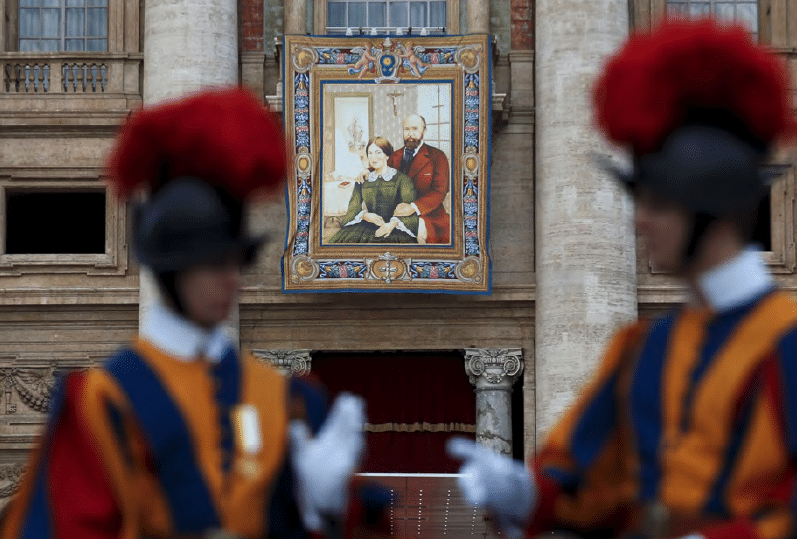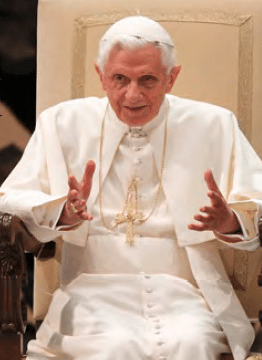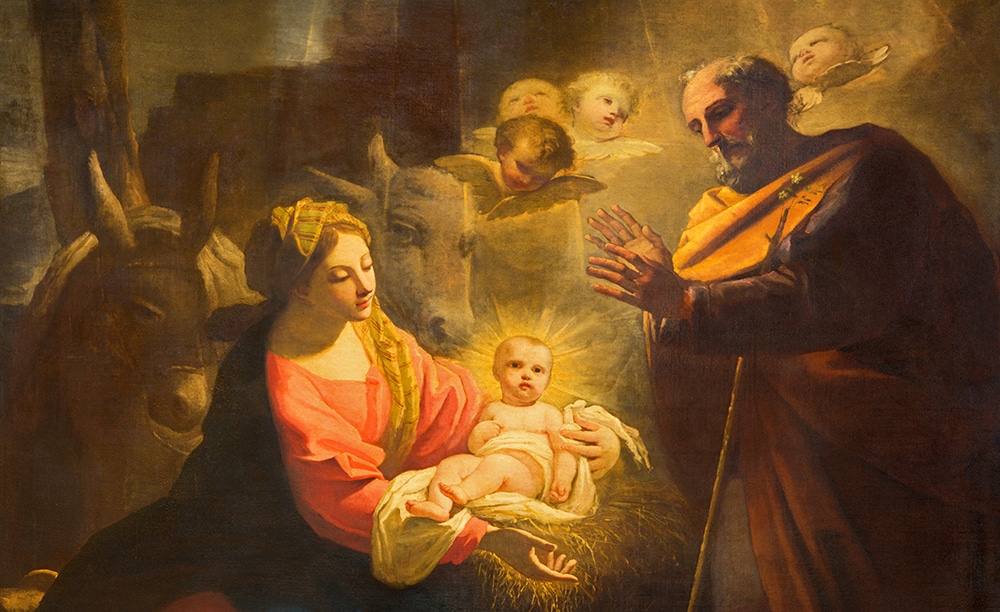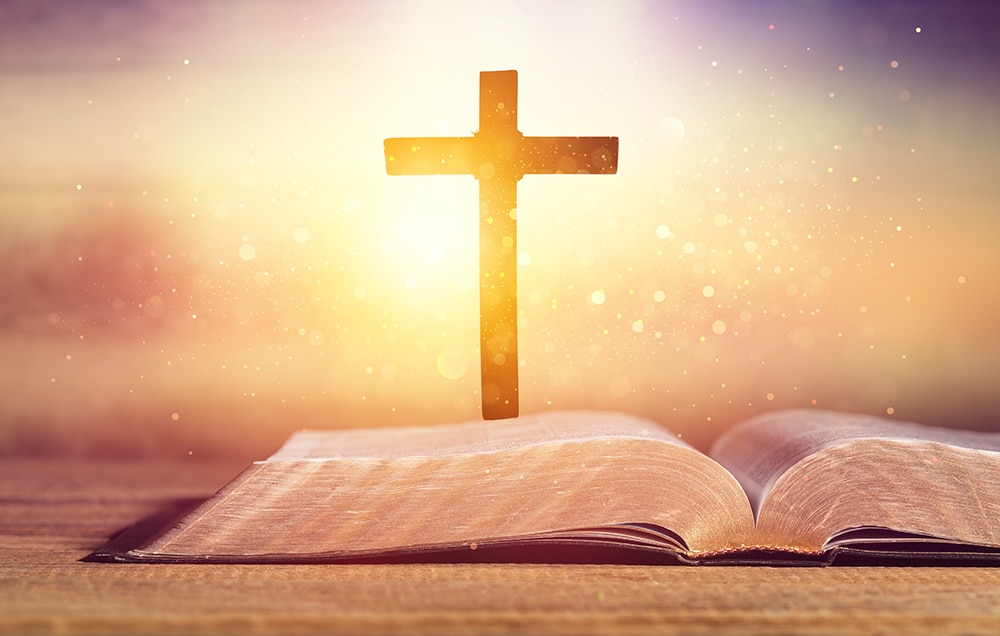My daughter goes to a Catholic elementary school with a robust religious life. Catholic identity here is more than just tenets of belief. It’s gritty. It’s multi-sensory.
This past May, she and I spent an evening picking out flowers together for a school-wide May crowning ceremony. I look forward to it every year because of the ways in which it draws together heaven and earth: The gentle perfume of our grocery store carnation commingles with gratitude and reverence for the Blessed Mother’s heavenly care for us. Here, a $5 flower becomes an invitation to the mystery of the Incarnation.
More regularly, there is a monthly family Holy Hour where the children sit before the altar with one of the school’s Dominican sisters. Worship music is played in the background (this time, for my daughter, by Mom), and the children learn to pray with the sister’s accompaniment and witness. Each time, I feel I’m able to peer directly into the Gospels and see Jesus among his beloved children. You can sense that Christ — ever ancient, ever new — moves with the same mercy and power in our own nondescript corner of the world as he did in the rural villages of Galilee so many years ago.
Questions of a child
This gritty and imaginative formation in the Faith is deeply Catholic. But the school doesn’t exist on an island. As my daughter has encountered and grown in the Faith, I’ve noticed her beginning to compare her experience with those of her friends and family, especially those who go to public schools. For her, public schools are like Catholic schools without religion. But since religion is so immersive in her education, she has trouble conceptualizing what that can mean. If schools can be “Catholic” or “public,” she’ll often ask the same about people: “Is my friend, Mary, Catholic or public?” She also once asked if the Olive Garden was Catholic or public as we arrived for butter noodles and breadsticks. We, of course, help her make the necessary distinctions, but it’s clear she’s trying to understand the landscape of the environment she inhabits.
This experience of faith formation being joined inseparably by an encounter with rival beliefs about God has become commonplace for nearly all of us.
While her experience of the Faith is transcendent, the context of her belief is a world where many don’t think and act and believe the same, particularly about God and the ways in which his transcendence shapes our daily lives. Many of the people she sees daily — family, neighbors, friends — believe differently, often in no God. This causes some sort of confusion that needs to be sorted out that makes her ask questions about her own faith: Why don’t they believe what I believe? Why don’t they go to Church on Sundays? Why don’t they believe in God? Why do we? If you hold still before these questions, they’re not easy to answer, especially for a child. The context creates a sort of self-consciousness in her faith; it can make it seem fragile.
This experience of faith formation being joined inseparably by an encounter with rival beliefs about God has become commonplace for nearly all of us. Your experience may not seem as pristine as a child’s, but, arriving at our theme, this sort of experience is a good entry point to understanding what is meant by the word “secular” or “secularity.” This is the experience of having faith in a secular age.

A secular age
In our daily language, “secular” is often used to say something is “not spiritual” or “not religious.” This is a negative definition, but in media and casual conversation, this is its most common use. There are also more constructive senses of the word. One of the most important of these is that secular describes how societies like our own create institutions without religious affiliation. We don’t have a faith-based congress, but a secular one. This model assumes there are two planes of existence in our world: One is secular, or of this world on its own, which hosts our governments and institutions, and the other is religious, which is typically about private beliefs about God. They don’t integrate; our secular world is closed off from the transcendent. When members of our society actively seek to advance something like this idea, we call it “secularism.”
The word is also used in a different form, as “secularization.” In this sense, it is a theory. The idea is that as society develops technologically and economically, religious faith will be subtracted ever more aggressively until it no longer has a meaningful presence. In other words, as society progresses, religious participation diminishes. It’s a prophetic interpretation of the future.
These are meaningful senses of the word we’re considering and are often used in our public discourse. But, they’re not the sense of the secular that we will be focusing on. They’re not what was described above in my daughter’s experience.
Having faith today
For practicing Catholics, the sense of “secular” that I’d like to focus on helps us to understand my daughter’s (and our own) world of belief. In this way, it’s not about being for or against faith, but rather about how we have faith in our circumstances. It comes from a Canadian philosopher named Charles Taylor. In 2007, he published a groundbreaking work entitled “A Secular Age,” a 900-page tome focused on what is meant by the word “secular” and how it came to be. But because its importance is matched only by its difficulty for the average person to digest, a cottage industry of “A Secular Age” summaries and application books has arisen. The ideas are so important that philosophers and theologians are trying to get them out to the masses in practical ways. Consider this article an introduction to these introductions to “A Secular Age.”
“Why was it virtually impossible not to believe in God in, say, 1500 in our Western society, while in 2000 [or 2023?] many of us find this not only easy, but even inescapable?”
Taylor begins his endeavor to understand the secular with a simple but illuminating question: “Why was it virtually impossible not to believe in God in, say, 1500 in our Western society, while in 2000 [or 2023?] many of us find this not only easy, but even inescapable?” The question isn’t gesturing toward whether or not society is or isn’t religious. It’s not about whether or not people are participating in churches. It’s not about religious diversity. Rather, for Taylor the focus is on how we believe, on what seems plausible to us. Taylor is suggesting that 500 years ago, a life without transcendence would be essentially unthinkable. The world was saturated with transcendent realities. God and other spiritual forces moved with power in the world and in individuals. We lived in an enchanted world. God was a fixture of reality. We may have had religious disagreements, but transcendence was typically always there.
Life in the world
Fast forward to our own context, not believing in God (or any view of transcendence) is not only an option, but for many in our society it feels like the only approach that’s plausible. God went from enchanting everything to being one option among many alternatives. For many, religious faith doesn’t seem to be a real option. That’s a cataclysmic cultural transformation. In James K.A. Smith’s introduction to Taylor’s work, he describes this as a foundational insight in Taylor’s analysis. A secular age is one where belief in God becomes radically contestable.
Fast forward to our own context, not believing in God (or any view of transcendence) is not only an option, but for many in our society it feels like the only approach that’s plausible.
What might this mean? My daughter has a rich and formative experience of the Faith in her school and home life. But her life in the world, be it her relationships, her dance studio and even the Olive Garden, present her, daily, with other views of life and what makes it meaningful. Many, if not most, of these stories offer views of the world with no reference to God whatsoever, a world locked in what Taylor calls an “immanent frame.” It’s a world with an impenetrable ceiling, closed off to the divine. Moreover, living in such a world creates “a sense that rival stories are always at the door offering a very different account of the world,” accounts which “call into question the fundamental story of faith.” Taylor will say that this exerts a profound pressure on believers, especially as we encounter these immanent frame stories more and more frequently among people in whom we see a lot of ourselves, people like our next door neighbors and classmates. This can make faith feel fragile, haunted by doubt.
Closed off to transcendence
And so while “secular” may refer to declines in religious participation or how we construct our institutions, “secular” in this sense refers to what Taylor calls this newfound context of belief, one that is fraught with different takes on transcendence and meaning. It is the background upon which we believe. We can’t run from it; our discipleship in the Faith is going to be caught up in this world of contested meanings. Our faith will grow within this contestability.
Upon this fundamental insight, Taylor’s work gives an historical account for how we ended up here. While this narrative will trace the historical and philosophical developments that led to our current secular age, it also functions to give language to what it feels like to carry faith in our moment. As Smith says, the proof of Taylor’s work isn’t so much in logical propositions, as it is in a sense of resonating with the descriptions he provides. He gives you a feel for our secular age. For the sake of growing in the Faith and understanding how to share the Gospel with the world we find ourselves in, this work is of incalculable value.
It is important to note that this account is different from an account of religious diversity, from living in a community where people believe different things about God or transcendence, more broadly. While in such a context there are contested meanings at play, secularity is about the world seeming closed off to anything eternal or divine. Here, we aren’t focused on disagreements about the divinity of Jesus Christ or what happens at Communion, for example. The concern is more about the plausibility of there being any meaningfully transcendent reality in a world that has come to be seen as knowable and livable on its own terms. As Taylor says, “a way of putting our present condition [our ‘secular age’] is to say that many people are happy living for goals which are purely immanent [of this world], they live in a way that takes no account of the transcendent.” In this context, the idea of a transcendent reality grounding and forming your life in concrete ways can feel forced or like a coping mechanism. Our cultural autopilot is an imagination for which God is just irrelevant; many people in our world have a very hard time imagining anything other than this.
Recovering the Incarnation
As mentioned, the above account is fantastically brief. There are dimensions to and detours within Taylor’s narrative that add stunning complexity and definition to the landscape he is describing. But even on this brief foundation, it’s fair to ask: what does this mean for us as Catholics?
Looking ahead in the life of the Church, Taylor says we will have to “struggle to recover a sense of what the Incarnation can mean.”
We have to recover a sense of what the Incarnation can mean because of the manifold, often hidden, ways that our secular age has shaped our sense of what might be possible with God.
The Incarnation names our belief that God, in the second person of the Trinity, has taken on our flesh in Jesus Christ in order to save us. He lived and moved among us, fully God and fully man. He ate breakfast, prayed in his home and in the synagogue, and worked and traveled on foot. He knew the heat of the noonday sun and the chill of a cold night. He was raised by a mother and father. He spoke amidst conflicts; he preached; he listened. He knew joy and mourning. And all the while, amid these “fully human” realities, he was fully God. Because of this, these mundane realities become enchanted sites; they reveal him. Through his full life, his death and his resurrection, he reveals his saving love for us, that God is not remote. All of our life and world has been drawn into his life for the sake of saving it. In him, we can see this world as it really is.
We have to recover a sense of what the Incarnation can mean because of the manifold, often hidden, ways that our secular age has shaped our sense of what might be possible with God. For the atheist, yes, secularity is conscious and deliberate. There are no transcendent realities; the world is knowable and livable on its own. But for all of us, even among believers, our secular age has settled into our bones, bit by bit. It’s formed us. The fragility we feel in our faith, the reality that much of our lives can be explained without an account of transcendence, all of this forms our expectations of the world, our hopes, our instincts and our desires. It has formed our sense of what reality is, and that reality is often a place where we struggle to see God. Our autopilot says that God is not our origin, our center, nor our destination, at least in any practically meaningful way.
| Pope Benedict XVI on secularism |
|---|
|
During his apostolic journey to the United States in 2008, Pope Benedict XVI met with the U.S. bishops and delivered an address responding to questions posted by the bishops. In the first question, “The Holy Father is asked to give his assessment of the challenge of increasing secularism in public life and relativism in intellectual life, and his advice on how to confront these challenges pastorally and evangelize more effectively.” Here is an excerpt from his answer: “It strikes me as significant that here in America, unlike many places in Europe, the secular mentality has not been intrinsically opposed to religion. Within the context of the separation of Church and State, American society has always been marked by a fundamental respect for religion and its public role, and, if polls are to be believed, the American people are deeply religious. But it is not enough to count on this traditional religiosity and go about business as usual, even as its foundations are being slowly undermined. A serious commitment to evangelization cannot prescind from a profound diagnosis of the real challenges the Gospel encounters in contemporary American culture. … “Perhaps America’s brand of secularism poses a particular problem: it allows for professing belief in God, and respects the public role of religion and the Churches, but at the same time it can subtly reduce religious belief to a lowest common denominator. Faith becomes a passive acceptance that certain things “out there” are true, but without practical relevance for everyday life. The result is a growing separation of faith from life: living “as if God did not exist”. … “Let me conclude, though, by saying that I believe that the Church in America, at this point in her history, is faced with the challenge of recapturing the Catholic vision of reality and presenting it, in an engaging and imaginative way, to a society which markets any number of recipes for human fulfillment.” |
Formed by the secular
So what should we do? I’d recommend any number of texts that offer profound reflections on how this context ought to shape the life of the Church and how we minister. But for this small space, here is what I walk away with.
We have to acknowledge that our minds and hearts have been formed by a context where belief in God seems more or less irrelevant to knowing the world and living well in it. Notre Dame sociologist Christian Smith describes the relevance of religious faith among young adults as on par with the general relevance of oil refineries to their lives. That may seem far-fetched, but the point is that they know refineries are there and are important in some abstract way, but unless someone has a personal hobby interest in them, there’s no reason to think about them in daily life. Living in this secular age means that we likely have some spiritual oil refineries in our lives, places where it’s hard to imagine God mattering much at all.
The trouble is these places are often difficult for us to see. This means that acknowledging them can only come through studying our lives. An incarnational spirituality needs to involve diving deeply into the narratives of Scripture and the lives of the saints, into deeply human accounts of life lived with God and of God’s life in Jesus Christ in our world, and discerning our own lives with these narratives, as mirrors.

Living like saints
Here’s an example to make this more concrete. A while back, my wife and I took a pilgrimage to Alençon and Lisieux, France, to some locations associated with Sts. Louis and Zélie Martin, the beloved parents of St. Thérèse of Lisieux. In the process, we read their letters to each other and all the biographies we could find. These letters are chock full of gritty, “fully human” realities. I remember one of my favorites involved Zélie lamenting a difficult toddler tantrum (Thérèse) while Louis was on the road as a salesman. We went to their home, which included a glimpse of the lace-making business they ran together. We went to the church in which they were married and walked the streets they knew from daily life. Taken together, they’re an “in the flesh” exemplar of how the vocation of marriage can be drawn into the life of Christ.
You can see how their sufferings (of which there were many) were transformed by sharing in Jesus’ suffering on the cross. While they struggled to see the hand of God in the mundane, they came to trust that the daily labor of raising children and earning an income, with all the patience required by both, were opportunities to participate in the love of Christ. Meals, sewing, sales pitches and parish breakfasts became a window to the divine. They became the fertile, Spirit-rich soil that bore incredible fruits of holiness.
As I walked the hallways of the Martin home, I felt like I could reach out and touch the workings of Providence. Such a recognition is easier here because we know the ending of their story. We know that God would call from this house one of the greatest saints of our time, St. Thérèse. Among many other great works, the daily life lived within those walls was used by God to produce her; it was all drawn up by him. Correspondingly, everything in the house felt enchanted, even the floorboards. And in some mysterious way, perhaps it all was. The artifacts of their daily life, be it tables and chairs or pots and pans, felt illuminated by the transcendence of their vocations.
Dishes are dishes, and bills are bills. They don’t automatically feel like they are the stage God is using to raise a saint.
In this way, this pilgrimage drew us into a more transcendent, vocational sense of our own marriage. For me, much of this was achieved by the sense of contrast that I felt. I realized that seeing my own daily life as a “Martin House” isn’t my autopilot. Dishes are dishes, and bills are bills. They don’t automatically feel like they are the stage God is using to raise a saint. And yet, the truth is that this Martin home “enchantment” is what’s really there. The Lord longs to use our home in the same way as he once did the Martin’s. They are an example of what the Incarnation can mean, even if we have to struggle to see it in our own lives. To remember this, we keep an icon of Sts. Louis and Zélie and all their children in our living room. It’s orchestrated like a Sears family photo, but is done in traditional iconographic style. It’s a beautiful window to what the Incarnation, ever ancient, ever new, can mean.






